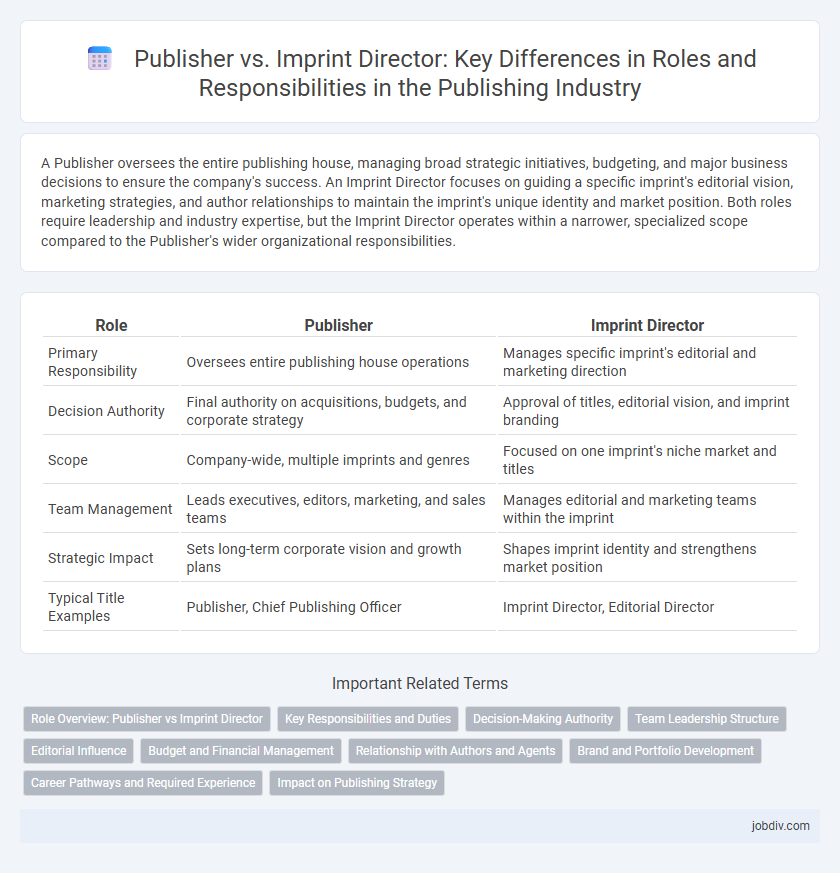A Publisher oversees the entire publishing house, managing broad strategic initiatives, budgeting, and major business decisions to ensure the company's success. An Imprint Director focuses on guiding a specific imprint's editorial vision, marketing strategies, and author relationships to maintain the imprint's unique identity and market position. Both roles require leadership and industry expertise, but the Imprint Director operates within a narrower, specialized scope compared to the Publisher's wider organizational responsibilities.
Table of Comparison
| Role | Publisher | Imprint Director |
|---|---|---|
| Primary Responsibility | Oversees entire publishing house operations | Manages specific imprint's editorial and marketing direction |
| Decision Authority | Final authority on acquisitions, budgets, and corporate strategy | Approval of titles, editorial vision, and imprint branding |
| Scope | Company-wide, multiple imprints and genres | Focused on one imprint's niche market and titles |
| Team Management | Leads executives, editors, marketing, and sales teams | Manages editorial and marketing teams within the imprint |
| Strategic Impact | Sets long-term corporate vision and growth plans | Shapes imprint identity and strengthens market position |
| Typical Title Examples | Publisher, Chief Publishing Officer | Imprint Director, Editorial Director |
Role Overview: Publisher vs Imprint Director
The Publisher holds overall responsibility for the strategic direction, financial performance, and market positioning of a publishing company, overseeing multiple imprints and departments. The Imprint Director focuses on managing a specific imprint, curating its editorial vision, acquiring titles, and guiding the imprint's identity within niche markets. Both roles require strong leadership and market insight, but the Publisher operates at a broader organizational level while the Imprint Director concentrates on specialized content and brand development.
Key Responsibilities and Duties
A Publisher oversees the entire publishing process, including strategic planning, budget management, and marketing, ensuring that the company's titles meet market demands and financial goals. An Imprint Director focuses on the creative and editorial direction of a specific imprint, managing acquisitions, editorial teams, and brand identity to maintain the imprint's unique voice. Both roles involve leadership and decision-making, but the Publisher has broader organizational responsibilities while the Imprint Director concentrates on developing a distinct catalog within the publisher's portfolio.
Decision-Making Authority
Publishers possess ultimate decision-making authority over a publishing company's strategic direction, acquisitions, and overall operations, shaping the company's market positioning and financial goals. Imprint Directors manage specific imprints with delegated decision-making power, focusing on editorial choices, imprint branding, and day-to-day operations within their niche. The distinction lies in the Publisher's broader, company-wide authority versus the Imprint Director's specialized, imprint-specific control.
Team Leadership Structure
A Publisher oversees the overall publishing strategy, financial goals, and high-level decision-making, leading cross-functional teams to ensure market success and brand growth. An Imprint Director manages a specific imprint within the publishing house, focusing on editorial direction, acquisitions, and day-to-day operations while leading a specialized team aligned with the imprint's vision. Together, they form a leadership structure where the Publisher drives company-wide objectives and the Imprint Director executes imprint-specific strategies for targeted audience engagement.
Editorial Influence
A Publisher oversees the entire publishing process, including financial decisions, marketing strategies, and overall brand direction, exerting broad editorial influence by setting general content standards and market positioning. An Imprint Director focuses on a specific division or niche within the publishing house, driving editorial vision and acquiring titles that align closely with the imprint's unique identity and audience. While the Publisher influences from a macro perspective, the Imprint Director shapes editorial content with targeted, specialized expertise, ensuring cohesive and distinctive publication portfolios.
Budget and Financial Management
The Publisher oversees the overall budget and financial strategy of the publishing house, ensuring profitability and resource allocation across all imprints. The Imprint Director manages the budget specific to their imprint, focusing on cost control and revenue generation within their niche market. Effective financial management at both levels is essential to balance investment in content acquisition, marketing, and production costs to achieve sustainable growth.
Relationship with Authors and Agents
A Publisher oversees the entire publishing process, including acquiring manuscripts and managing contracts, maintaining direct relationships with authors and agents to ensure successful book launches and marketing strategies. An Imprint Director focuses on a specific imprint's editorial vision and brand identity, cultivating closer, more specialized relationships with authors and agents aligned with the imprint's niche. Both roles require strong communication and negotiation skills, but the Publisher handles broader strategic partnerships while the Imprint Director emphasizes personalized author and agent engagement within targeted genres.
Brand and Portfolio Development
A Publisher focuses on overarching brand strategy and the comprehensive portfolio development across multiple genres and markets to maximize market reach and profitability. An Imprint Director hones in on curating a distinct brand identity within a specialized niche, driving targeted content acquisition and marketing efforts to cultivate a loyal audience. Both roles collaborate to strengthen overall portfolio synergy while maintaining clear brand differentiation.
Career Pathways and Required Experience
A Publisher typically requires extensive experience in rights management, marketing, and overall business strategy, often progressing from editorial or sales roles, while an Imprint Director focuses more on curating the editorial vision and building author relationships within a specific genre or market segment. Career pathways for Publisher roles demand strong leadership and financial acumen, frequently attained through years in senior management roles, whereas Imprint Directors usually emerge from editorial backgrounds with deep expertise in content curation and brand development. Both positions necessitate significant industry knowledge, but Publishers emphasize broader operational oversight, and Imprint Directors specialize in niche market positioning and creative direction.
Impact on Publishing Strategy
A Publisher sets the overall vision and business objectives for the publishing house, influencing market positioning, portfolio diversification, and financial goals. An Imprint Director manages the editorial direction and brand identity of a specific imprint, tailoring acquisition strategies to target niche audiences and genres. Their combined impact shapes the cohesive publishing strategy, balancing broad market trends with specialized content development.
Publisher vs Imprint Director Infographic

 jobdiv.com
jobdiv.com